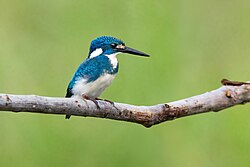Biology:Cerulean kingfisher
| Cerulean kingfisher | |
|---|---|

| |
| Scientific classification | |
| Domain: | Eukaryota |
| Kingdom: | Animalia |
| Phylum: | Chordata |
| Class: | Aves |
| Order: | Coraciiformes |
| Family: | Alcedinidae |
| Subfamily: | Alcedininae |
| Genus: | Alcedo |
| Species: | A. coerulescens
|
| Binomial name | |
| Alcedo coerulescens Vieillot, 1818
| |
The cerulean kingfisher (Alcedo coerulescens) is a kingfisher in the subfamily Alcedininae which is native to parts of Indonesia. With an overall metallic blue impression, it is very similar to the common kingfisher, but it is white underneath instead of orange. Males average bluer than females, which have a greenish cast.
This species is sometimes called the small blue kingfisher but in Indonesia and parts of Asia that name refers to Alcedo atthis (common kingfisher).[2]
Taxonomy
The first formal description of the cerulean kingfisher was by the French ornithologist Louis Pierre Vieillot in 1818. He coined the binomial name Alcedo coerulescens.[3][4] The specific epithet coerulescens is from the Latin caerulescens meaning "bluish".[5] The species is monotypic.[6]
Description
The cerulean kingfisher is a small kingfisher with a length of 13 cm (5.1 in). The upperparts are a range of shades of blue with white lores and a prominent white patch on each side of the neck. The underparts are white with an azure-blue breast-band. The bill is blackish and the legs are dark brown. The female has duller and slightly greenish plumage and a narrower breast band.[7]
Distribution and habitat
The cerulean kingfisher is native to Sumatra, Java, the Kangean Islands, Bali, Lombok and Sumbawa, all in Indonesia. It is a resident species that inhabits low-lying areas near streams, canals, flooded paddy-fields and tidal estuaries.[7]
References
- ↑ BirdLife International (2016). "Alcedo coerulescens". IUCN Red List of Threatened Species 2016: e.T22683117A92976544. https://www.iucnredlist.org/species/22683117/92976544. Retrieved 25 September 2021.
- ↑ Ali, S.; Ripley, S.D. (2001). "Bird Number 722-724". Handbook of the Birds of India and Pakistan. 4 (Second ed.). New Delhi: Oxford University Press. pp. 72–78.
- ↑ Vieillot, Louis Pierre (1818) (in French). Nouveau dictionnaire d'histoire naturelle, appliquée aux arts, à l'agriculture, à l'économie rurale et domestique, à la médecine, etc.. 19. Paris: Deterville. p. 401. https://www.biodiversitylibrary.org/page/18042135.
- ↑ Peters, James Lee, ed (1945). Check-list of Birds of the World. 5. Cambridge, Massachusetts: Harvard University Press. p. 175. https://www.biodiversitylibrary.org/page/14480186.
- ↑ Jobling, J.A. (2010). The Helm Dictionary of Scientific Bird Names. London: Christopher Helm. p. 113. ISBN 978-1-4081-2501-4. https://archive.org/details/Helm_Dictionary_of_Scientific_Bird_Names_by_James_A._Jobling.
- ↑ Gill, F.; Donsker, D., eds (2017). "Rollers, ground rollers & kingfishers". World Bird List Version 7.2. International Ornithologists' Union. http://www.worldbirdnames.org/bow/rollers/.
- ↑ 7.0 7.1 Fry, C. H.; Fry, K.; Harris, A. (1992). Kingfishers, Bee-eaters, and Rollers. London: Christopher Helm. pp. 210–211. ISBN 978-0-7136-8028-7.
Wikidata ☰ Q31646 entry
 |


